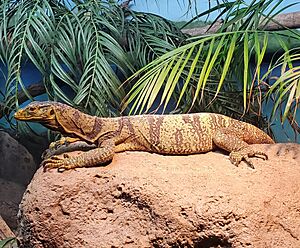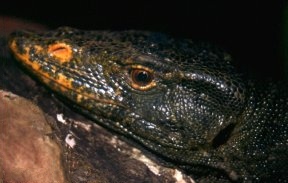Gray's monitor facts for kids
Quick facts for kids Gray's monitor |
|
|---|---|
 |
|
| Conservation status | |
| Scientific classification | |
| Genus: |
Varanus
|
| Species: |
olivaceus
|
 |
|
| Range of Varanus olivaceus | |
The Gray's monitor (Varanus olivaceus) is a very large monitor lizard. It can grow up to 180 centimeters (about 6 feet) long. It can also weigh more than 9 kilograms (about 20 pounds). This lizard lives only in the lowland forests of the Philippines. You can find it on islands like southern Luzon, Catanduanes, and Polillo Island.
People also call this lizard the butaan or ornate monitor. It spends most of its time in trees, meaning it is arboreal. It is also a very shy animal. For a long time, scientists thought a similar lizard in northern Luzon was the same species. But in 2010, they realized it was a different kind of monitor lizard. They named it the northern Sierra Madre forest monitor.
Contents
Life and Habits
What the Gray's Monitor Eats
The Gray's monitor is famous for its unusual diet. Most monitor lizards eat meat, but the Gray's monitor mainly eats ripe fruit. It especially loves Pandanus fruit.
Even though fruit is its main food, it also eats other things. These include snails, crabs, spiders, and beetles. It also eats birds and their eggs. In zoos, these monitors eat grapes and fruit powder. They also get insects and small rodents.
Reproduction and Life Cycle
Scientists do not know much about how Gray's monitors breed in the wild. This is because they are very secretive animals. We do know that they usually lay eggs between July and October. A female can lay up to 11 eggs at one time.
Instead of digging a nest, they likely lay their eggs in tree hollows. They also rest in these hollows during the day. Young monitors are often seen from May to July. This suggests that the eggs hatch after about 300 days. In zoos, eggs have hatched in about 219 days.
Protecting the Gray's Monitor
Threats to the Species
The Gray's monitor is listed as a vulnerable animal by the IUCN. This means it is at risk of becoming endangered. A big reason for this is that much of its habitat has been destroyed. Over the last 100 years, many forests where they live have disappeared.
Now, they live in small, separate areas. These areas cover less than 20,000 square kilometers. Besides losing their homes, they are also hunted for food. Some are also caught and sold as pets.
Gray's Monitors in Zoos
This species is not common in zoos around the world. It is also hard to breed them successfully in captivity. However, some zoos outside the Philippines have them on display.
These include:
- Los Angeles Zoo
- Oklahoma City Zoo and Botanical Garden
- Protvin Krokozoo
- Plzen Zoo
- Brookfield Zoo
- San Diego Zoo
- Bronx Zoo
- Fresno Chaffee Zoo
In the Philippines, the Avilon Zoo has successfully bred this species. For many years, the Dallas Zoo was the only place outside the Philippines to hatch a baby in 1994. Then, the LA Zoo successfully hatched them in 2015. The two female monitors from Dallas Zoo moved to the Oklahoma City Zoo in 2013.



